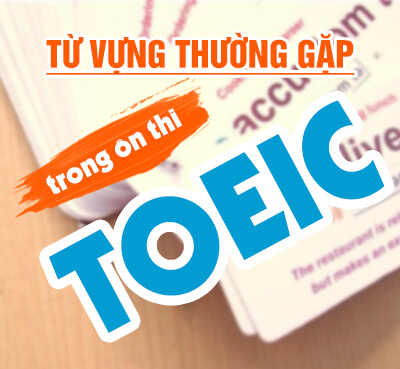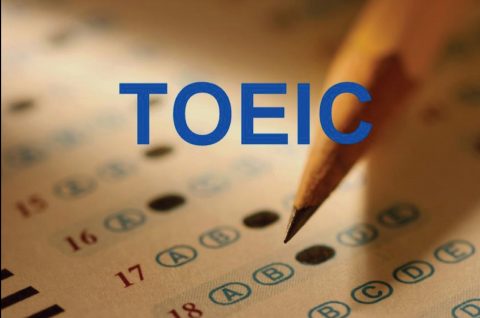Học từ vựng TOEIC là một phần quan trọng không thể thiếu. Từ vựng hay gặp nhất trong kỳ thi TOEIC bao gồm những từ vựng cơ bản với tần số sử dụng cao nhất, nên ngay từ bây giờ, khi bắt đầu học từ, các bạn nên quản lý chặt quá trình học từ vựng một cách có khoa học.
Hãy tải tài liệu song ngữ anh việt Tổng hợp từ vựng ôn thi TOEIC thường gặp trong đề thi TOEIC và ôn lại những từ mình chưa thuộc và xem lại những từ đã thuộc để đảm bảo mình không quên mất bạn nhé. Dưới cuối bài viết có tổng hợp hơn 200 bài báo song ngữ Anh – Việt các bạn có thể tải về xem nhé.
Hôm nay TuhocIELTS cung cấp cho bạn Tổng hợp từ vựng ôn thi TOEIC (song ngữ Anh – Việt) thường gặp trong đề thi TOEIC giúp bạn học Từ vựng TOEIC hiệu quả. Các bạn cùng tham khảo nội dung ở dưới nhé!
Ngoài ra, bạn có thể xem thêm 1 số tài liệu để ôn luyện thi TOEIC hiệu quả:
- Mozilge New TOEIC Actual Test Part 5, 6
- 600 Essential words for the TOEIC
- Tài liệu ETS TOEIC Test RC 1000
I. Nội dung tổng hợp từ vựng ôn thi TOEIC thường gặp trong đề thi TOEIC
What the book is about
The TOEIC (Test of English for International Communication) test measures the English proficiency of people working in international business or planning to use English to communicate with others. Although the test does not specifically test specialized vocabulary, the items on the exam are in specialized contexts.
This book will provide you with a basis to understand these specialized contexts that are often used on the TOEIC test. Each chapter covers a particular context that has appeared on the TOEIC test. The new words taught in each chapter are not specialized words. These words are more what is called general vocabulary. They can be used in many contexts.
How ever, these new words are used in a specialized context. Understanding these contexts and the words used in these contexts will help you improve your score on the TOEIC exam.
II. Cuốn sách từ vựng ôn thi TOEIC này có gì?
Bài thi TOEIC (Trắc nghiệm tiếng Anh trong giao tiếp quốc tế) đánh giá sự thành thạo tiếng Anh của người làm việc trong kinh doanh quốc tế hoặc dự định dùng tiếng Anh để giao tiếp với người khác. Mặc dù bài thi không chuyên về kiểm tra các từ chuyên môn (specialized vocabulary), nhưng các câu trong bài thi đều nằm trong các ngữ cảnh đặc trưng (specialized contexts).
Cuốn sách này sẽ cung cấp cho bạn một nền tảng để hiểu được những ngữ cảnh đặc trưng này mà chúng thường được dùng trong bài thi TOEIC. Mỗi chương bao gồm một ngữ cảnh đặc trưng (particular context) đã xuất hiện trong bài thi TOEIC. Những từ mới được dạy trong mỗi chương không phải là từ chuyên môn. Chúng thường được gọi là những từ vựng thông dụng. Chúng có thể sử dụng trong nhiều ngữ cảnh.
Tuy nhiên, những từ mới này lại được dùng trong những ngữ cảnh đặc trưng. Hiểu về những ngữ cảnh này và những từ được dùng trong đó sẽ giúp bạn cải thiện được điểm số trong kỳ thi TOEIC.
How to use this book
This book could also be titled 50 Day to a More Powerful Vocabulary. There are 50 lessons. Every day, you can study one lesson. Every day you can learn 12 new words. In 50 days, you can learn 600 new words – words that will help you understand English better. And the better you understand English, the higher your TOEIC score will be.
You can sit down and in 30 minutes finish a lesson. But that is not the best way. To learn a new word, you must use it over and over. Try to spread your studying out over the whole day. Do a little bit whenever you have some free time. The 12 new words are used over and over in this lesson. Studying these words throughout the day will help you learn them and never forget them.
Start in the morning and look over the 12 new words and their definitions. Repeat them out loud. During the morning, read over the conversations. If your can, say the conversations out loud. The more way you use a word (listening, speaking, reading, and writing), the better the chance you will remember it.
In the afternoon, do the exercises. In the evening, do the very last exercise. The last exercise is like a mini-test. It will tell you if you completely understood the meaning of the word and how to use it in a sentence.
Every day, do another lesson. At the end of the week, do the Word Review. I am sure you will answer every question correctly. Most of the new words you learn in one lesson will be used again in another lesson. We recycle words just as we recycle paper. If you forget a meaning of a word, look up the word in the Word Index at the back of the book. That will tell you in which lesson you can find a definition and the pronunciation.
You will note that the order of the activities is different from that on the TOEIC test. On the TOEIC test, Listening Comprehension is first, followed by Reading. I think it is easier to learn a new word by reading it than hearing it. Consequently, I have reversed the order in each chapter. First you will read the word (Parts V, VI and VII), and then you will hear the word (Parts I, II, III, and IV).
III. Dùng sách từ vựng ôn thi TOEIC này như thế nào?

Cuốn sách cũng có thể đặt tựa là “50 ngày để nâng cao vốn từ”. Có 50 bài. Mỗi ngày, bạn có thể học một bài. Mỗi ngày bạn có thể học được 12 từ mới. Trong 50 ngày, bạn có thể học được 600 từ – những từ đó sẽ giúp bạn hiểu tiếng Anh tốt hơn. Càng hiểu tiếng Anh tốt hơn thì điểm thi TOEIC của bạn càng sẽ cao hơn.
Bạn có thể ngồi học một lèo trong 30 phút để xong một bài. Nhưng đó không phải là cách tốt nhất. Để học một từ mới, bạn phải dùng chúng nhiều lần. Cố gắng trải việc học ra suốt cả ngày. Học chút một mỗi khi bạn có thời gian rảnh. 12 từ mới được dùng đi dùng lại trong bài này. Học trong suốt cả ngày sẽ giúp bạn thuộc được từ và không bao giờ quên chúng.
Bắt đầu vào buổi sáng và xem bao quát 12 từ mới và định nghĩa của chúng. Đọc lớn lại các từ này. Trong buổi sáng, đọc lướt qua các đoạn đàm thoại. Nếu có thể bạn hãy nói lớn các đoạn đàm thoại. Càng dùng một từ theo nhiều cách (nghe, nói, đọc, viết) thì bạn càng có cơ hội ghi nhớ chúng.
Vào buổi chiều, hãy làm các bài tập. Đến tối thì làm bài tập cuối cùng. Bài tập cuối cùng giống như một bài kiểm tra mini. Nó sẽ cho bạn biết mình đã hoàn toàn hiểu nghĩa từ chưa và làm sao để dùng nó trong câu. Cứ mỗi ngày bạn lại làm một bài khác. Đến cuối tuần thì làm bài ôn tập từ. Tôi chắc rằng bạn sẽ trả lời được mọi câu hỏi một cách chính xác.
Phần lớn các từ mà bạn học trong một bài sẽ được dùng lại trong bài khác. Chúng ta “tái chế” lại các từ cũng như tái chế lại giấy. Nếu bạn quên nghĩa của một từ, hãy tra ở phần cuối sách. Nó sẽ cho bạn biết bài nào bạn có thể tìm ra được định nghĩa và phát âm của từ đó.
Bạn sẽ nhận thấy rằng trình tự các hoạt động (trong sách này) khác với trong bài thi TOEIC. Trong bài thi TOEIC, phần Nghe tổng hợp được làm trước tiên, theo sau là phần Đọc. Tôi nghĩ rằng sẽ dễ hơn nếu học từ mới bằng cách đọc nó hơn là nghe. Do đó, tôi đã đảo ngược thứ tự trong mỗi chương. Trước tiên, bạn sẽ đọc các từ (các Phần V, VI và VII), và sau đó mới là nghe chúng (các Phần I, II, III và IV).
Strategies to improve your vocabulary
The English language consists of more than 250,000 words, far more than most other languages – far more than we can include in this book. Here are some strategies that will have you remember words that you come across either in this book or in English books or
magazines. To learn a new word, of course, you first have to run across it. Therefore, you must read in English as much as you can. The best way to improve your vocabulary is to read routinely. The more you read, the more words you will encounter. The more words you run across, the more you will learn.
Once you have gotten into the habit of reading, you can systematically build your vocabulary by doing five things:
- Analyze word parts.
- Recognize grammatical forms.
- Recognize word families.
- Make your own personal dictionary.
- Keep a daily reading log.
Các chiến lược để tăng cường vốn từ của bạn
Anh ngữ bao gồm hơn 250 ngàn từ, nhiều hơn phần lớn ngôn ngữ khác – nhiều hơn (những từ mà) chúng ta có thể bao gồm trong sách này. Sau đây là một số chiến lược sẽ giúp bạn nhớ được các từ mà bạn có thể bắt gặp trong sách này hoặc trong các sách tiếng Anh hoặc trong các tạp chí.
Để học một từ mới, dĩ nhiên trước hết bạn phải bắt gặp nó. Vì vậy, bạn phải đọc tiếng Anh nhiều mỗi khi bạn có thể. Cách tốt nhất để tăng cường vốn từ của bạn là đọc đều đặn. Càng đọc nhiều thì bạn các bắt gặp (encounter) nhiều từ. Càng bắt gặp (run across) nhiều từ thì bạn càng học được chúng.
Một khi bạn đã “nhiễm” thói quen đọc, bạn có thể xây dựng một cách có hệ thống vốn từ của mình bằng cách thực hiện 5 việc sau:
- Phân tích các thành phần từ (thành tố từ).
- Nhận diện các dạng ngữ pháp (hình thái ngữ pháp).
- Nhận diện các họ từ.
- Tạo riêng từ điển cá nhân của bạn.
- Duy trì nhật ký đọc hàng ngày.
Many English words have Greek and Latin prefixes, roots, and suffixes. Memorizing a comprehensive list will increase your vocabulary exponentially. For example, a prefix is the part of a word that comes at the beginning of a word, like the prefix pre- at the beginning of the word prefix.
The prefix pre- means before. Once you learn the meaning of this prefix, you will be able to use it to help you figure out the meaning of a new word that contains the same prefix, for example, predetermine, predict, predecessor.
- Look at these other examples.
- Prefix re- happens a second time
- Root circul around
- Suffix -tion the act of
- Word recirculation repeating the act of motion in a circular path
- Prefix re- happens a second time
- Root gener bring to life
- Suffix -tion the act of
- Word regeneration the act of being brought to life again
- Prefix re- happens a second time
- Root loc place
- Suffix -tion the act of
- Word relocation the act of moving again to another place
By understand that the prefix re- means again, you know that any word that begins with re- means something happens a second time. Students who become familiar with the most common prefixes, roots, and suffixes find that their vocabulary grows quickly. Examples of these prefixes, roots, and suffixes will be given throughout the book.
1. Phân tích các thành tố từ
Nhiều từ tiếng Anh có tiền tố, hậu tố và từ gốc Hy Lạp và Latin. Ghi nhớ một danh sách toàn diện sẽ gia tăng vốn từ của bạn một cách nhanh chóng (theo hàm mũ). Ví dụ một tiền tố là một phần của từ đặt tại phần đầu của một từ, như tiền tố -pre tại phần đầu của từ prefix. Tiền tố -pre có nghĩa là before (trước).
Một khi bạn học nghĩa một tiền tố này, thì bạn sẽ có thể dùng nó để giúp bạn hiểu ra (figure out) ý nghĩa của từ mới có chứa cùng tiền đó, ví dụ, predetermine (quyết định trước), predict (tiên đoán), predecessor (tiền bối, người tiền nhiệm).
Hãy xem các ví dự sau đây:
- Prefix re- xảy ra ở lần thứ 2
- Root circul vòng quanh, xung quanh
- Suffix -tion sự hành động của
- Word recirculation lặp lại hành động di chuyển một vòng (sự tuần hoàn)
- Prefix re- xảy ra ở lần thứ 2
- Root gener mang đến sự sống
- Suffix -tion sự hành động của
- Word regeneration hành động mang lại sự sống (sự tái sinh)
- Prefix re- xảy ra ở lần thứ 2
- Root loc nơi chốn
- Suffix -tion sự hành động của
- Word relocation hành động lại di chuyển đến nơi khác (sự tái định vị)
2. Recognize grammatical forms
Being familiar with all grammatical forms of a word helps you increase your vocabulary. Suffixes often give you a clue as to the meaning of a word and its grammatical position in a sentence. These suffixes can tell you whether the word may be a noun, verb, adjective, or adverb.
Common noun endings:
- -tion competition
- -ance deliverance
- -ence independence
- -ment government
- -ism Buddhism
- -ship friendship
- -ity community
- -er teacher
- -or doctor
- -ee attendee
Common verb endings:
- -ize memorize
- -ate refrigerate
- -en lengthen
Common adjective endings:
- -y happy
- -ous mountainous
- -ious serious
- -able capable
- -al musical
- -ic athletic
- -ful beautiful
- -less careless
Common adverb ending:
- -ly quickly

Learning about grammatical forms will help you identify the purpose of many words. As the endings become recognizable, they will help you figure out the meaning of new words.
Example of these word forms will be given throughout the book.
3. Nhận diện các hình thái ngữ pháp
Làm quen với tất cả hình thái ngữ pháp của một từ sẽ giúp bạn gia tăng vốn từ. Các hậu tố thường giúp bạn manh mối nhận biết ý nghĩa của một từ và vị thế/vai trò ngữ pháp của nó trong câu. Những hậu tố này cho bạn biết một từ có thể là danh từ, động từ, tính từ, hoặc trạng từ hay không.
Các đuôi danh từ phổ biến:
- -tion competition (sự cạnh tranh)
- -ance deliverance (lời tuyên bố, sự cứu thoát)
- -ence independence (sự độc lập)
- -ment government (chính quyền, chính phủ)
- -ism Buddhism (đạo Phật)
- -ship friendship (tình bạn)
- -ity community (cộng đồng)
- -er teacher (thầy giáo)
- -or doctor (bác sĩ)
- -ee attendee (người tham dự)
Các đuôi động từ phổ biến:
- -ize memorize (ghi nhớ)
- -ate refrigerate (làm lạnh)
- -en lengthen (làm dài)
Các đuôi tính từ phổ biến:
- -y happy (hạnh phúc)
- -ous mountainous (có núi, to lớn)
- -ious serious (nghiêm túc)
- -able capable (có khả năng)
- -al musical (thuộc âm nhạc)
- -ic athletic (thuộc thể thao, lực lưỡng)
- -ful beautiful (xinh đẹp)
- -less careless (cẩu thả)
Đuôi trạng từ phổ biến:
- -ly quickly (một cách nhanh chóng)
Học về các hình thái ngữ pháp sẽ giúp bạn xác định được mục đích của nhiều từ. Khi mà các đuôi (từ) trở nên có thể nhận biết, chúng sẽ giúp bạn nhận ra ý nghĩa của những từ mới.
Các ví dụ về những hình thái từ này sẽ được đưa ra trong suốt cuốn sách này.
4. Recognize word families
Like brothers and sisters in the same family, words can be related, too. These words have the same base but different grammatical forms. They are part of a word family. When you learn a new word, look in the dictionary for words in the same word family. Write them beside the word in your own dictionary. Make columns for nouns, verbs, adjectives, and adverbs and write down the words in the same family. For example:
- verb noun adjective adverb
- to care care careful carefully
- to attend attendance attentive attentively
- to point pointer pointed pointedly
Some members of a word family have all grammatical forms; others have just a few. Some words even have two grammatical forms of the same part of speech, but with different meanings like the nouns attendance and attendee. Examples of word families will be given throughout the book.
5. Nhận diện các họ từ
Tương tự như anh chị em trong cùng một gia đình, các từ cũng có thể có quan hệ với nhau. Những từ này có cùng cơ sở nhưng khác hình thái ngữ pháp. Chúng là một phần (thành viên) của một họ từ. Khi bạn học một từ mới, tìm trong từ điển những từ nào trong cùng họ từ. Viết chúng bên cạnh từ mới ở trong từ điển riêng của bạn. Tạo các cột cho danh từ, động từ, tính từ và trạng từ và viết ra các từ trong cùng một họ. Ví dụ:
- verb noun adjective adverb
- to care care careful carefully chăm sóc
- to attend attendance attentive attentively chăm sóc, tham dự
- to point pointer pointed pointedly chỉ, trỏ, đầu nhọn
Vài thành viên của một họ từ có tất cả các hình thái ngữ pháp; một số khác chỉ có một phần. Một số từ thậm chí có 2 hình thái ngữ pháp của cùng một phần lời nói (đúng hơn là: của một cột trong họ từ), nhưng khác nghĩa như là các danh từ attendance (sự tham dự) và attendee (người tham dự). Các ví dụ về các họ từ sẽ được đưa ra trong suốt cuốn sách này.
6. Make your own personal dictionary
Create your own dictionary to keep track of all the new words you learn. Your own personal dictionary should look like a regular dictionary with different pages for words beginning with A, B, C, and so on.
You can photocopy the following sample dictionary page or you can use a sheet of paper to make one page for each letter of the alphabet. Put tabs on these pages and write the letter of the alphabet on the tab so you can find each letter more easily. You can add pages as necessary.
When you read or hear new words, you should write them in your own personal dictionary. You may even find other words in this book that you do not know. You can write these words in your personal dictionary, too. Try not to look up the meanings of these new words immediately. This will slow down your reading. Try to get the general meaning from the context. You can look up the specific meaning after you have formed a hypothesis.
Next to each word in your own personal dictionary, write the definition and make up a sentence including the word, using the dictionary as a guide. If possible, write the sentence where you orginally discovered the word or a sentence whose context reminds you of the meaning.
While you are looking in the dictionary, search for words in the same word family. Write these words in your personal dictionary and make up sentences for these words, too. Notice which endings occur in each grammatical form. Writing these sentences will help you remember the word later. It’s easier to remember words when you put them in context.
The more you use a word, the more likely you will remember it. If you choose not to create your own personal dictionary, you can keep track of new words as you look them up in a regular dictionary. Take a yellow highlight pen and highlight the word you look up. At the end of the week or month, you can thumb through the dictionary and see at a glance how many words you have added to your vocabulary.
7. Tạo riêng từ điển cá nhân của bạn
Tạo một từ điển riêng của bạn để theo dõi tất cả từ mới mà bạn học. Từ điển cá nhân của bạn nên giống như một từ điển thông thường với những trang khác nhau cho mỗi từ bắt đầu theo A, B, C, v..v…
Bạn có thể sao chụp trang từ điển mẫu ở dưới đây hoặc bạn có thể dùng một tờ giấy để tạo một trang cho mỗi chữ cái trong bảng chữ cái. Gắn nhãn cho những trang này và viết chữ cái vào nhãn để cho bạn có thể tìm thấy mỗi chữ một cách dễ dàng hơn. Bạn có thể bổ sung thêm trang nếu cần.
Khi bạn đọc hoặc nghe từ mới, bạn nên viết chúng vào từ điển riêng. Bạn thậm chí còn có thể tìm những từ khác trong sách này mà bạn không biết. Bạn cũng có thể ghi những từ này vào từ điển riêng. Cố gắng đừng tìm nghĩa của những từ mới ngay lập tức. Điều này sẽ làm chậm việc đọc của bạn. Cố gắng nhận biết ý nghĩa chung dựa theo ngữ cảnh. Bạn có thể tìm nghĩa cụ thể sau khi bạn đã tạo xong giả thuyết (về nghĩa của từ).
Kế bên mỗi từ trong từ điển riêng, bạn ghi định nghĩa và đặt ra một câu bao gồm từ (mới học), dùng từ điển làm vật hướng dẫn. Nếu có thể, bạn ghi ra câu mà tại đó bạn bắt đầu phát hiện ra từ mới hoặc một câu mà ngữ cảnh của nó nhắc nhớ cho bạn ý nghĩa (của từ).
Khi đang dò tìm trong từ điển, tìm ra những từ trong cùng họ từ. Viết những từ này vào từ điển cá nhân và cũng đặt câu cho những từ này. Lưu ý những đuôi từ xuất hiện trong mỗi hình thái ngữ pháp.
Viết ra những câu này sẽ giúp bạn nhớ lại về sau. Từ sẽ dễ nhớ hơn khi bạn đặt chúng vào trong ngữ cảnh. Càng sử dụng nhiều một từ, bạn có thể càng nhớ nó hơn. Nếu bạn không chọn việc tạo ra một từ điển riêng của bạn, thì bạn có thể theo dõi những từ mới trong khi bạn tìm kiếm chúng ở từ điển thông thường. Lấy một viết dạ quang màu vàng và tô sáng từ bạn tìm kiếm.
Đến cuối tuần hay cuối tháng, bạn có thể dở nhanh suốt từ điển và liếc xem có bao nhiêu từ bạn đã bổ sung vào vốn từ của mình.
8. Keep a daily reading log
It is important that you read something in English every day. You should set aside as much time as you can spare, but try to set aside at least 20 to 30 minutes every day just for reading and writing something in English. This time should not be used for reading text assigned from class or work. Select something that interests you and is appropriate for your level. It should not be too easy or too difficult. Here are samples of short passages you could read:
- The sports section of the newspaper.
- An article from a popular magazine.
- A chapter from a novel.
- The label from an English/American product.
- An advertisement in English.
- Web pages on any subject in English.
Try to vary the type of reading. Don’t read only science journals or mystery novels. You want to build your vocabulary in a variety of areas. On the internet, look at news sites such as www.cnn.com, www.msnbc.com, www.abc.com. These sites have a variety of links to many different kinds of subjects such as weather, business, sports, politics, law, technology, science and space, health, entertainment, travel, education, and many more.
If you need special vocabulary for your job or course work, you could focus on these types of Web sites. But remember, the reading log should be material in addition to assigned readings.
Try to pick a time of day when your mind is alert. Don’t try to study when you are tired.
Follow these steps to build a reading log:
1. Read WITHOUT stopping for about ten minutes.
The first time you read a passage, do NOT stop to look up words. Native English readers often come across words they do not know in their reading. They get a general idea of the meaning of unknown words from the context. See if you can also get the gist of the idea without looking up the words in a dictionary.
2. Reread the passage and highlight unknown or unclear words.
You can use a yellow highlight pen or underline the word. If you aren’t permitted to write in the book, write the words down in you reading log.
3. Choose five key words.
From all the words that you did not understand completely, select five of them for your dictionary. These should be word that kept you from understanding and entire sentence.
Write a summary about the passage you read and add it to your reading log. Summarize what you’ve read in approximately a three-sentence paragraph. If possible, make a copy of the passage or cut it out and paste it under the summary. If you’re reading a book, write the title, pages read, and a summary of the story or argument of the book. Try to use your five new key words in your summary.
9. Duy trì nhật ký đọc hàng ngày
Điều quan trọng là bạn đọc cái gì đó bằng tiếng Anh hàng ngày. Bạn nên dành riêng ra (set aside) mức tối đa thời gian rảnh mà bạn có, nhưng cố gắng dành ra tối thiểu 20-30 phút để đọc và viết tiếng Anh. Thời gian này không nên dùng cho việc đọc các bài được giao (assigned) trong lớp hoặc trong công việc. Chọn những bài khiến bạn hứng thú và phù hợp với trình độ của bạn. Nó không nên dễ quá hoặc khó quá. Sau đây là vài mẫu đoạn văn ngắn mà bạn có thể đọc:
- Mục thể thao trên báo.
- Một bài báo trên tờ báo phổ biến.
- Một chưong tiểu thuyết.
- Nhãn hàng hóa Anh/Mỹ.
- Mẫu quảng cáo bằng tiếng Anh.
- Những trang web với chủ đề nào đó bằng tiếng Anh.
Cố gắng thay đổi các kiểu đọc. Đừng nên chỉ đọc các tạp chí khoa học hoặc các tiểu thuyết trinh thám. Bạn muốn xây dựng vốn từ của mình trong nhiều lãnh vực. Trên mạng internet, tìm những site tin tức như CNN, MSNBC, ABC.
Đây là những site có nhiều liên kết đa dạng đến nhiều đề tài như thời tiết, kinh doanh, thể thao, chính trị, luật pháp, công nghệ, khoa học và không gian, y tế, giải trí, du lịch, giáo dục và còn nhiều nữa. Nếu bạn cần từ vựng đặc biệt (chuyên môn) cho công việc hoặc cho khóa học của mình, bạn nên tập trung vào những website có nội dung này. Nhưng hãy nhớ rằng, nhật ký đọc chỉ nên là tài liệu thêm vào việc đọc được giao trong lớp.
Cố gắng chọn những thời gian trong ngày khi mà trí óc bạn tỉnh táo. Đừng cố học khi bạn thấy mệt mỏi.

Làm theo những bước sau đây để xây dựng một nhật ký đọc:
1. Đọc không ngừng trong khoảng 10 phút.
Lần đầu tiên đọc không được ngừng lại để tìm nghĩa của từ. Những người đọc tiếng Anh bản ngữ thường bắt gặp các từ mà họ không biết nghĩa trong khi đang đọc. Họ tìm ra ý nghĩa chung chung của từ không biết dựa theo ngữ cảnh. Hãy xem bạn cũng có thể đoán được ý chính mà không phải tra từ điển không.
2. Đọc lại đoạn văn và đánh dấu nổi bật những từ không biết hoặc không rõ nghĩa.
Bạn có thể dùng bút dạ quang màu vàng hoặc gạch dưới từ. Nếu bạn không được phép viết vào sách thì hãy viết các từ vào nhật ký đọc của bạn.
3. Chọn ra 5 từ khóa.
Trong tất cả những từ mà bạn hoàn toàn không hiểu, chọn ra 5 từ trong số đó cho từ điển riêng của bạn (đưa vào từ điển này). Đây là những từ đã ngăn cản việc bạn hiểu được toàn bộ câu.
Viết ra một tóm tắt về đoạn văn mà bạn đã đọc và thêm chúng vào nhật ký đọc. Tóm tắt những gì bạn đã đọc vào một đoạn khoảng chừng 3 câu. Nếu có thể, tạo một bản sao của đoạn văn hoặc cắt và dán nó vào dưới đoạn tóm tắt.. Nếu bạn đang đọc một cuốn sách, hãy viết lại tựa sách, số trang đã đọc và một bài tóm tắt về câu chuyện hoặc chủ đề của cuốn sách. Cố gắng dùng 5 từ khóa trong bài tóm tắt này.
IV. Tổng hợp từ vựng ôn thi TOEIC thường gặp trong đề thi TOEIC
1. abide by /ə’baid/ (v): tôn trọng, tuân theo, giữ (lời)
- a. The two parties agreed to abide by the judge’s decision.
- b. For years he has abided by a commitment to annual employee raises.
- a. Hai đảng phái đồng ý sẽ tôn trọng phán quyết của quan tòa.
- b. Trong hàng năm trời, ông ta đã giữ lời cam kết tăng lương cho nhân viên.
2. agreement /ə’gri:mənt/ (n): hợp đồng, giao kèo, sự đồng ý/thỏa thuận với nhau
- a. The landlord and tenant were in agreement that the rent should be prorated to the middle of the month.
- b. According to the agreement, the caterer will also supply the flowers for the event.
- a. Người chủ và người thuê đã đồng ý rằng tiền thuê sẽ được chia theo tỷ lệ đến giữa tháng.
- b. Theo thỏa thuận, nhà cung cấp (đồ ăn uống) cũng sẽ cung cấp hoa cho sự kiện.
3. assurance /ə’ʃʊərəns/ (n): sự cam đoan, bảo đảm, chắc chắn; sự tin chắc, tự tin
- a. The sales associate gave his assurance that the missing keyboard would be replaced the next day.
- b. Her self-assurance made it easy to see why she was in charge of the negotiations.
- a. Người bán hàng đưa ra lời cam đoan cái bàn phím bị thiếu sẽ được thay vào ngày mai.
- b. Sự tự tin của cô ta khiến người ta dễ hiểu được tại sao cô ta chịu trách nhiệm đàm phán.
4. cancellation /,kænsə’leiʃn/ (n): sự bãi bỏ, hủy bỏ
- a. The cancellation of her flight caused her problems for the rest of the week.
- b. The cancellation clause appears at the back of the contract.
- a. Sự hủy bỏ chuyến bay của cô ta đã gây rắc rối cho cô ta trong suốt phần còn lại của tuần lễ.
- b. Điều khoản hủy bỏ xuất hiện tại phần cuối của bản hợp đồng.
5. determine /di’tɜ:min/ (v): quyết định, xác định; quyết tâm, kiên quyết
- a. After reading the contract, I was still unable to determine if our company was liable for back wages.
- b. The skill of the union bargainers will determine whether the automotive plant will open next week.
- a. Sau khi đọc bản hợp đồng, tôi vẫn không thể quyết định liệu công ty chúng tôi có chịu trách nhiệm về các khoản nợ lương hay không.
- b. Kỹ năng của những nhà thương lượng sẽ quyết định nhà máy tự động có được mở cửa vào tuần tới không.
6. engagement /in’geidʒmənt/ (n): sự hứa hẹn, hứa hôn;
- a. The engagement begins at 7:30.
- b. The entire office was invited to her engagement party.
- a. Lễ hứa hôn bắt đầu lúc 7:30.
- b. Toàn bộ văn phòng đã được mời đến dự lễ đính hôn của cô ta.
7. establish /is’tæbliʃ/ (v): thiết lập, thành lập; xác minh, chứng minh, củng cố
- a. Through her many books and interviews, Dr. Wan established herself as an authority on conflict resolution.
- b. The merger of the two companies established a powerful new corporation.
- a. Nhờ những cuốn sách và các cuộc phỏng vấn của mình, TS Wan đã tự chứng tỏ được bà là người có uy tín trong việc giải quyết xung đột.
- b. Sự hợp nhất giữa 2 công ty đã tạo ra một tập đoàn mới hùng mạnh.
8. obligate /’ɒbligeit/ (v): bắt buộc
- a. The contractor was obligated by the contract to work 40 hours a week.
- b. I felt obligated to finish the project even though I could have exercised my option to quit.
- a. Nhà thầu đã bị bắt buộc theo hợp đồng phải làm việc 40 giờ một tuần.
- b. Tôi thấy bắt buộc phải hoàn thành dự án, mặc dù thậm chí tôi có thể sử dụng quyền chọn lựa là ngừng lại.
9. party /’pɑ:ti/ (n): đảng, phái, đội, nhóm; người tham dự/tham gia; buổi liên hoan, buổi tiệc
- a. The parties agreed to a settlement in their contract dispute.
- b. The party that prepares the contract has a distinct advantage.
- a. Các đảng phái đã đồng ý dàn xếp sự bất đồng về thỏa thuận của họ.
- b. Đảng nào mà soạn thảo hợp đồng thì có một lợi thế rõ ràng.
10. provision /prə’viʒn/ (n): sự dự liệu, dự trữ, dự phòng, cung cấp; điều khoản
- a. The father made provisions for his children through his will.
- b. The contract contains a provision to deal with how payments are made if John loses his job.
- a. Người cha đã chu cấp cho những đứa con vì sự quyết tâm/nguyện vọng của ông ta.
- b. Hợp đồng có một điều khoản để giải quyết về cách thanh toán được thực hiện ra sao nếu như John mất việc.
11. resolve /ri’zɒlv/ (v): giải quyết, quyết định; (n): quyết tâm, kiên quyết
- a. The mediator was able to resolve the problem to everyone’s satisfaction.
- b. The businessman resolved to clean out all the files by the end of the week.
- a. Người trung gian dàn xếp có thể giải quyết vấn đề để làm thỏa mãn tất cả mọi người.
- b. Người doanh nhân quyết định dọn sạch mọi hồ sơ trước cuối tuần này.
12. specific /spə’sifik/ (adj): riêng biệt, cụ thể, đặc trưng
- a. The customer’s specific complaint was not addressed in his e-mail.
- b. In a contract, one specific word can change the meaning dramatically.
- a. Lời phàn nàn cụ thể của khách hàng đã không được ghi thẳng trong email của ông ta.
- b. Trong một hợp đồng, một từ cụ thể có thể làm thay đổi hoàn toàn ý nghĩa.
Word Families:
- verb agree If both parties agree to the terms, we can finalize the contract.
- noun agreement As soon as the labor agreement was signed, the factory
- resumed production of new cars and vans.
- adjective agreeable The parties are agreeable to the terms.
- verb assure I assure you that our drug-testing policy is applied fairly.
- noun assurance What assurance is there that the company will still be in business?
- adverb assuredly He spoke assuredly, but his follow-up memo showed less conviction.
- verb cancel The man canceled his magazine subscription and got his money back.
- noun cancellation Writers usually receive a cancellation fee even if their articles are not published.
- adjective canceled The canceled concert ended up costing our agency millions.
- verb obligate The terms of the contracts obligate us to work for at least one more month.
- noun obligation The factory managers have a legal and moral obligation to provide a safe work site.
- adjective obligatory He finished his obligatory military service, and then joined his father on the orange farm.
- verb provide Since the machine is very reliable, why don’t we cancel the service contract they provided?
- noun provider We must negotiate a new contract with our Internet service provider.
- noun provision The provision for canceling the contract is in the last clause.
- verb specific The contract specifies the percentage of raise the workers will see next year.
- noun specification The work was done according to our specifications.
- adjective specific We have not chosen a specific location for the reunion.
V. Bài tập Tổng hợp từ vựng ôn thi TOEIC thường gặp trong đề thi TOEIC
Choose the word that best completes the sentence.
1. The two sides were no closer to a final ___ at midnight than they were at noon.
(A) agreement (C) agree
(B) agreeable (D) agreed
2. Our union representative ___ members that our rights would be defended.
(A) assured (C) assuredly
(B) assurance (D) assure
3. If you ___ your reservation 48 hours in advance, you will not be billed.
(A) will cancel (C) cancellation
(B) cancel (D) canceled
4. I dont’t feel any ___ to give my boss more than two weeks notice when I leave.
(A) oblige (C) obliged
(B) obligatory (D) obligation
5. The ___ for terminating the contract were not discused.
(A) provide (C) provider
(B) provisions (D) provisioning
6. The contract calls for the union to ___ who their bargaining representative will be.
(A) specific (C) specifying
(B) specification (D) specify
Error Recognition
Choose the underlined word or phrase that should be rewritten and rewrite it.
7. When attempts at resolve failed, both parties, determined to end the conflict, agreed to enter into a formal contract and promised to abide by the terms.
8. Both parties agreed that the contractor would provide technical assistance 24 hours a day, so it was easy to determination that the two-day delay was not acceptable.
9. We were assured by the cable company, before we engaged in a contract, that we could cancellation our membership at any time with no further obligations.
10. Our car insurance establishments the time period within which they provide assistance, determines the repair shops we can use, sets a fee structure for payment, and provides a forum for resolving billing errors.
Reading Comprehension
Read the following passage and write the words in the blanks below.
- abide by cancel establishment provide
- agreement determine obligates resolve
- assurance engaging parties specifies
Contracts are an integral part of the workplace. In simple terms, contracts are an (11.)
___ between two or more (12.) ___ that (13.) ___ terms and (14.) ___ the parties to
follow them. Contracts often include the amount that a client will pay contractors and
what services will be provided. For example, in your office, you may have a contract that
provides (15.) ___ that your copier machine or phones will be repaired within a certain
amount of time. This service can either be done off-site or at your (16.) ___. A contract
often states ways to (17.) ___ if quality of work delivered is acceptable. Well-written
contracts usually (18.) ___ ways to (19.) ___ problems like these when they happen.
Before (20.) ___ in a contract, both parties should think carefully, as they will have to
(21.) ___ the conditions specified in it. A contract usually specifies how the two parties
can (22.) ___ it if either party fails to meet the terms.
VI. Tải tài liệu Tổng hợp từ vựng ôn thi TOEIC thường gặp trong đề thi TOEIC (song ngữ Anh – Việt)
Link download tài liệu ôn thi TOEIC Song ngữ Anh – Việt:
Tổng hợp từ vựng ôn thi TOEIC thường gặp trong đề thi TOEIC (song ngữ Anh – Việt)
Bên dưới đây tiếp là tổng hợp 200 bài báo song ngữ Anh – Việt giúp bạn tăng vốn từ vựng cho bản thân
Link tải sách: Website cập nhật tin tức tiếng Anh hiệu quả dành cho người Việt
Chúc bạn tải về học tập tốt nhé.
Nguồn: www.tuhocielts.vn








Bình luận